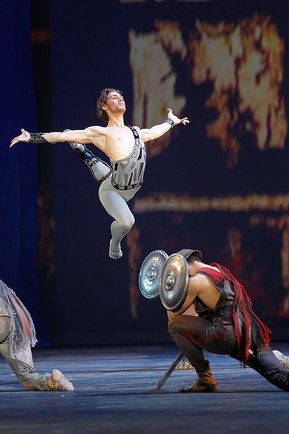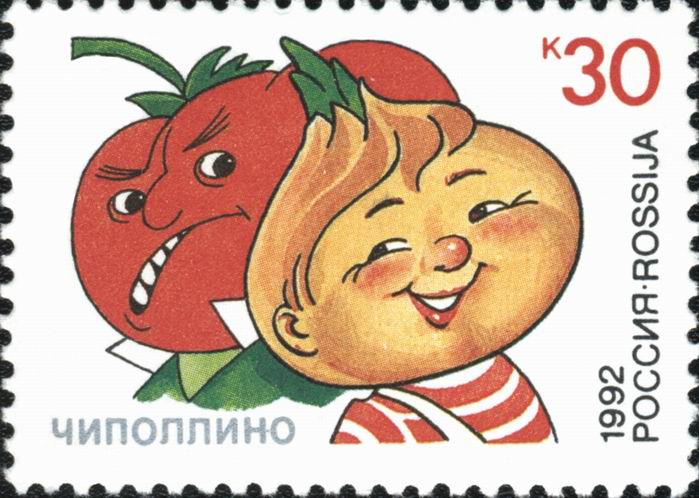|
Elena Evseeva
Elena Evseeva (russian: Елена Евсeева) (born 13 December 1982, Izhevsk) is a Russian ballerina, soloist of the Mikhailovsky (2001—2008) and the Mariinsky (since 2008) theaters. Honored Artist of the Republic of Udmurtia. Biography Elena Evseeva was born in Izhevsk; her father is an economist and mother is a master of sports in artistic gymnastics. During her childhood she moved to Perm, where she joined the Perm Ballet School. At the age of 14, a teacher from the Ballet theater of Boris Eifman noticed Elena at the International Ballet Competition held in Moscow and advised her parents to transfer her to the Vaganova Academy of Russian Ballet. That’s how Elena came to study ballet in St. Petersburg. In 2001 she graduated from the Academy in the class of Honored Art Worker Marina Vasilieva and was taken to the ballet troupe of the Mikhailovsky Theatre. There she was a leading soloist from 2001 to 2008. Since 2008, she is dancing in the Mariinsky Theatre o ... [...More Info...] [...Related Items...] OR: [Wikipedia] [Google] [Baidu] |
Izhevsk
Izhevsk (russian: Иже́вск, p=ɪˈʐɛfsk; udm, Ижкар, ''Ižkar'', or , ''Iž'') is the capital city of Udmurtia, Russia. It is situated along the Izh River, west of the Ural Mountains in Eastern Europe. It is the 21st-largest city in Russia, and the most populous in Udmurtia, with over 600,000 inhabitants. From 1984 to 1987, the city was called Ustinov (russian: Усти́нов), named after Soviet Minister of Defence Dmitry Ustinov.Izhlife.ruКак Ижевск 900 дней был Устиновым The city is a major hub of industry, commerce, politics, culture and education in the Volga Region. It is known for its defense, engineering and metallurgy industries. Izhevsk has the titles of the Armory Capital of Russia and the City of Labor Glory. History Pioneer settlements The pioneer settlements on the territory where modern Izhevsk now stands were founded by Udmurts in the 5th century. There were two fortified settlements situated on the banks of the Karlut ... [...More Info...] [...Related Items...] OR: [Wikipedia] [Google] [Baidu] |
Marius Petipa
Marius Ivanovich Petipa (russian: Мариус Иванович Петипа), born Victor Marius Alphonse Petipa (11 March 1818), was a French ballet dancer, pedagogue and choreographer. Petipa is one of the most influential ballet masters and choreographers in ballet history. Marius Petipa is noted for his long career as ''Premier maître de ballet'' (''First Ballet Master'') of the St. Petersburg Imperial Theatres, making him Ballet Master and principal choreographer of the Imperial Ballet (today known as the Mariinsky Ballet), a position he held from 1871 until 1903. Petipa created over fifty ballets, some of which have survived in versions either faithful to, inspired by, or reconstructed from the original. Among these works, he is most noted for ''The Pharaoh's Daughter'' (1862); ''Don Quixote'' (1869); ''La Bayadère'' (1877); '' Le Talisman'' (1889); '' The Sleeping Beauty'' (1890); ''The Nutcracker'' (choreographed jointly with Lev Ivanov) (1892); ''Le Réveil de Flor ... [...More Info...] [...Related Items...] OR: [Wikipedia] [Google] [Baidu] |
Jules Perrot
Jules-Joseph Perrot (18 August 1810 – 29 August 1892) was a dancer and choreographer who later became Ballet Master of the Imperial Ballet in St. Petersburg, Russia. He created some of the most famous ballets of the 19th century including ''Pas de Quatre'', '' La Esmeralda'', '' Ondine'', and ''Giselle'' with Jean Coralli. From dancer to balletmaster The Lyon-born Perrot danced often with Marie Taglioni but their partnership was short-lived. She eventually refused to dance with him fearing that he would outshine her. He left the Opéra in 1835 to tour European dance centers such as London, Milan, Vienna and Naples, where he met and noticed the talent of Carlotta Grisi. He coached her and presented her to the world as the next great ballerina in an 1836 performance in London with himself as her partner.Review: ''King's Theatre'', in ''The Times'', Wednesday 13 April 1836, p. 5, column C. Following the success of his contributions to the choreography of ''Giselle'', Perrot ... [...More Info...] [...Related Items...] OR: [Wikipedia] [Google] [Baidu] |
Jean Coralli
Jean Coralli (15 January 1779 – 1 May 1854) was a French ballet dancer and choreographer, best known for collaborating with Jules Perrot in creating ''Giselle'' (1841), the quintessential Romantic ballet of the nineteenth century. Early life and career Born Giovanni Coralli Peracini, he was a son of a Bolognese family resident in Paris, where his father was a comedian at the Théâtre Italien. As a child he studied at the ballet school of the Paris Opera but chose to go to Vienna to make his debut as a dancer and choreographer. He danced for a short while at the Paris Opera in 1802 and at the King's Theatre in London and then returned to Vienna to assume the position of ballet master at the Hoftheater (Court Theater). During these early years, he and his wife formed the celebrated dancing couple Giovanni and Teresa Coralli and were often pictured in contemporary prints. They danced leading roles in most of the ballets that Coralli created at the Hoftheater, including ''Helena u ... [...More Info...] [...Related Items...] OR: [Wikipedia] [Google] [Baidu] |
August Bournonville
August Bournonville (21 August 1805 – 30 November 1879) was a Danish ballet master and choreographer. He was the son of Antoine Bournonville, a dancer and choreographer trained under the French choreographer, Jean Georges Noverre, and the nephew of Julie Alix de la Fay, née Bournonville, of the Royal Swedish Ballet. Bournonville was born in Copenhagen, Denmark, where his father had settled. He trained with his father Antoine Bournonville as well he studied under the Italian choreographer Vincenzo Galeotti at the Royal Danish Ballet, Copenhagen, and in Paris, France, under French dancer Auguste Vestris. He initiated a unique style in ballet known as the Bournonville School. Following studies in Paris as a young man, Bournonville became solo dancer at the Royal Ballet in Copenhagen. From 1830 to 1848 he was choreographer for the Royal Danish Ballet, for which he created more than 50 ballets admired for their exuberance, lightness and beauty. He created a style which, althoug ... [...More Info...] [...Related Items...] OR: [Wikipedia] [Google] [Baidu] |
La Sylphide
''La Sylphide'' ( en, The Sylph; da, Sylfiden) is a romantic ballet in two acts. There were two versions of the ballet; the original choreographed by Filippo Taglioni in 1832, and a second version choreographed by August Bournonville in 1836. Bournonville's is the only version known to have survived and is one of the world's oldest surviving ballets. Taglioni version On 12 March 1832 the first version of ''La Sylphide'' premiered at the Salle Le Peletier of the Paris Opéra with choreography by the groundbreaking Italian choreographer Filippo Taglioni and music by Jean Schneitzhoeffer, Jean-Madeleine Schneitzhoeffer. Taglioni designed the work as a showcase for his daughter Marie Taglioni, Marie. ''La Sylphide'' was the first ballet where dancing ''en pointe'' had an aesthetic rationale and was not merely an acrobatic stunt, often involving ungraceful arm movements and exertions, as had been the approach of dancers in the late 1820s. Marie was known for shortening her skirts ... [...More Info...] [...Related Items...] OR: [Wikipedia] [Google] [Baidu] |
Faust (opera)
''Faust'' is an opera in five acts by Charles Gounod to a French libretto by Jules Barbier and Michel Carré from Carré's play ''Faust et Marguerite'', in turn loosely based on Johann Wolfgang von Goethe's ''Faust, Part One''. It debuted at the Théâtre Lyrique on the Boulevard du Temple in Paris on 19 March 1859, with influential sets designed by Charles-Antoine Cambon and Joseph Thierry, Jean Émile Daran, Édouard Desplechin, and Philippe Chaperon. Performance history The original version of Faust employed spoken dialogue, and it was in this form that the work was first performed. The manager of the Théâtre Lyrique, Léon Carvalho cast his wife Caroline Miolan-Carvalho as Marguerite and there were various changes during production, including the removal and contraction of several numbers. The tenor Hector Gruyer was originally cast as Faust but was found to be inadequate during rehearsals, being eventually replaced by a principal of the Opéra-Comique, Joseph-Théodore ... [...More Info...] [...Related Items...] OR: [Wikipedia] [Google] [Baidu] |
Spartacus (ballet)
''Spartacus'' (russian: «Спартак», Spartak) is a ballet by Aram Khachaturian (1903–1978). The work follows the exploits of Spartacus, the leader of the slave uprising against the Romans known as the Third Servile War, although the ballet's storyline takes considerable liberties with the historical record. Khachaturian composed ''Spartacus'' in 1954, and was awarded a Lenin Prize for the composition that same year. It was first staged in Leningrad on 27 December 1956, as choreographed by Leonid Yakobson, for the Kirov Theatre of Opera and Ballet (Mariinsky Theatre), where it stayed in repertory for many years, but only with qualified success since Yakobson abandoned conventional ''pointe'' in his choreography. Yakobson restaged his version for the Bolshoi in 1962 and it was part of the Bolshoi's 1962 tour to New York. The ballet received its first staging at the Bolshoi Theatre, Moscow in 1958, choreographed by Igor Moiseyev; however it was the 1968 production, choreograp ... [...More Info...] [...Related Items...] OR: [Wikipedia] [Google] [Baidu] |
Chipollino (ballet)
Cipollino (), or Little Onion as translated from the original, is a fictional character from Gianni Rodari's eponymous ''Tale of Cipollino'' ( it, Il romanzo di Cipollino), also known under its 1957 renamed title ''Adventures of Cipollino'' ( it, Le avventure di Cipollino), a children's tale about political oppression. He also appeared before the publication of the book in the children's magazine '' Il Pioniere'' of which Rodari was the editor. Cipollino was popular in the Soviet Union, up to the point of being adapted as a ballet composed by Karen Khachaturian and choreographed by Genrikh Mayorov, originally staged in Taras Shevchenko National Opera and Ballet Theatre of Ukraine on November 8 1974. In a world inhabited by anthropomorphic produce, Cipollino fights the unjust treatment of his fellow vegetable townsfolk by the fruit royalty (Prince Lemon and the overly proud Lord Tomato) in the garden kingdom. The main theme is the struggle of the underclass against the powerful ... [...More Info...] [...Related Items...] OR: [Wikipedia] [Google] [Baidu] |
Swan Lake
''Swan Lake'' ( rus, Лебеди́ное о́зеро, r=Lebedínoye ózero, p=lʲɪbʲɪˈdʲinəjə ˈozʲɪrə, link=no ), Op. 20, is a ballet composed by Russian composer Pyotr Ilyich Tchaikovsky in 1875–76. Despite its initial failure, it is now one of the most popular ballets of all time. The scenario, initially in two acts, was fashioned from Russian and German folk tales and tells the story of Odette, a princess turned into a swan by an evil sorcerer's curse. The choreographer of the original production was Julius Reisinger (Václav Reisinger). The ballet was premiered by the Bolshoi Ballet on at the Bolshoi Theatre in Moscow. Although it is presented in many different versions, most ballet companies base their stagings both choreographically and musically on the 1895 revival of Marius Petipa and Lev Ivanov, first staged for the Imperial Ballet on 15 January 1895, at the Mariinsky Theatre in St. Petersburg. For this revival, Tchaikovsky's score was revised by ... [...More Info...] [...Related Items...] OR: [Wikipedia] [Google] [Baidu] |








